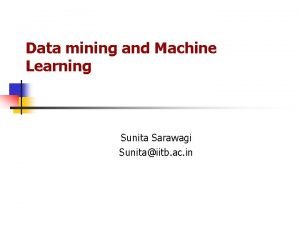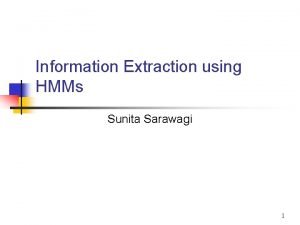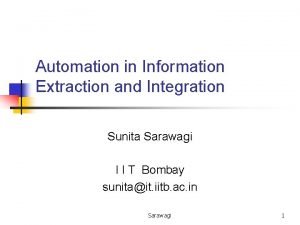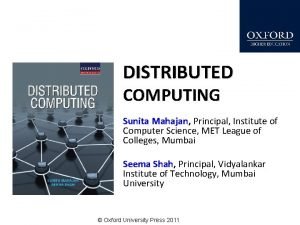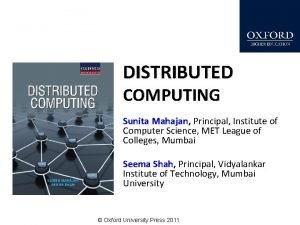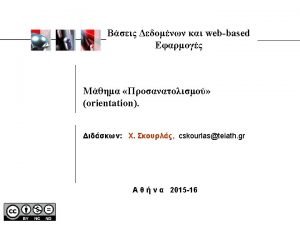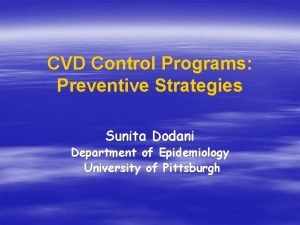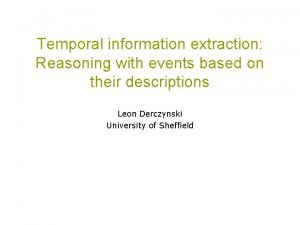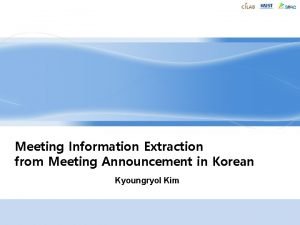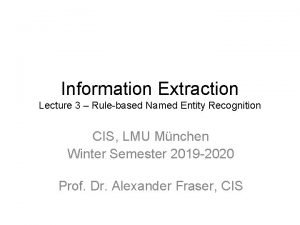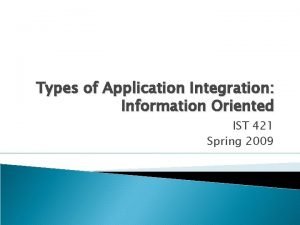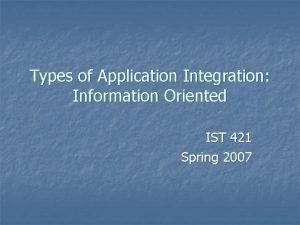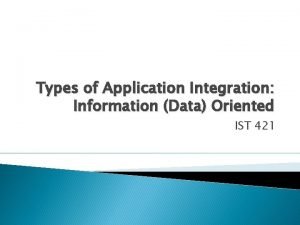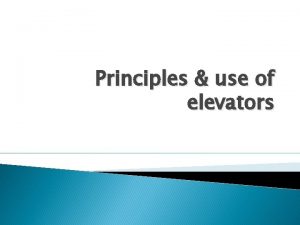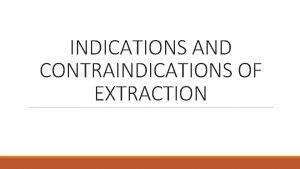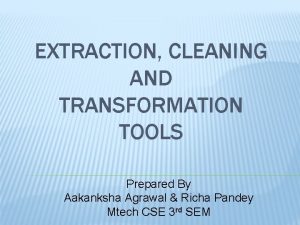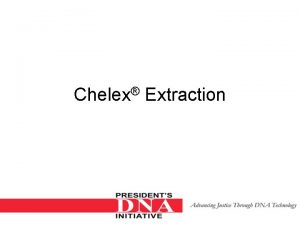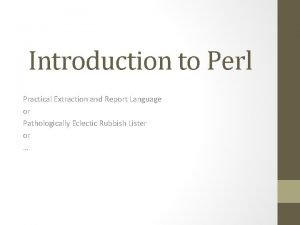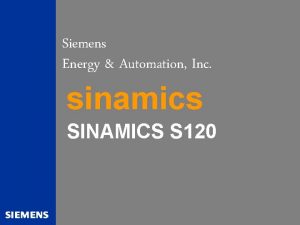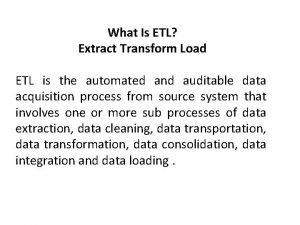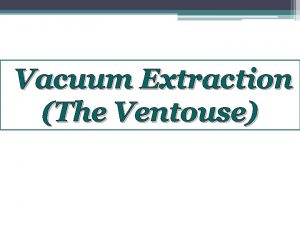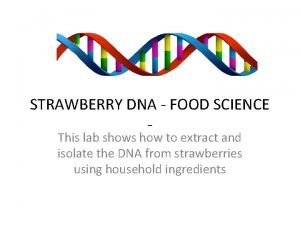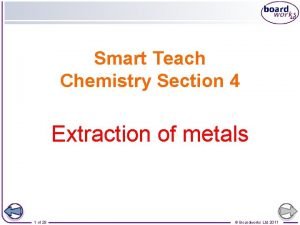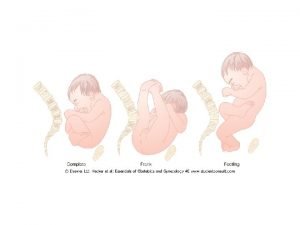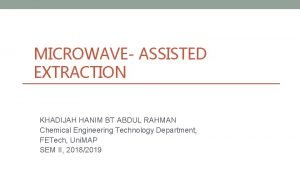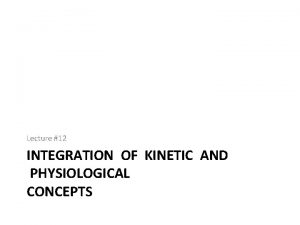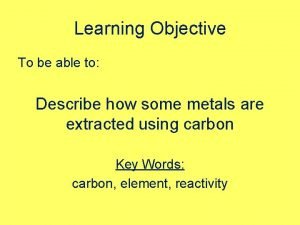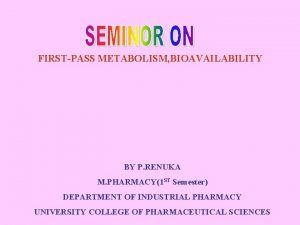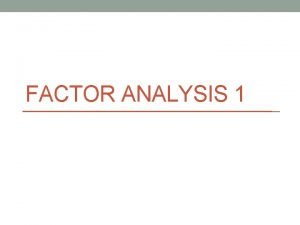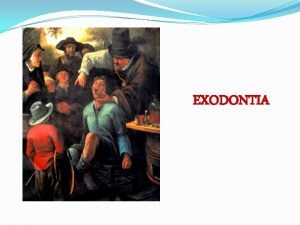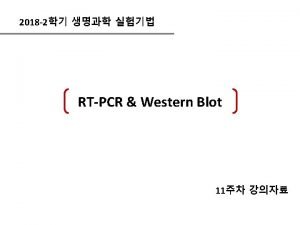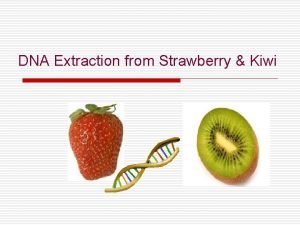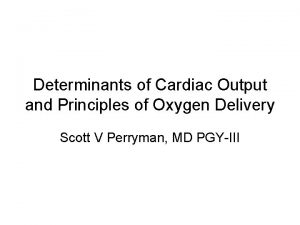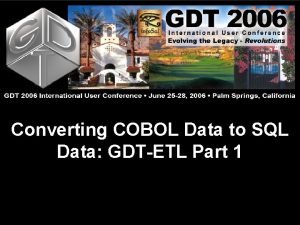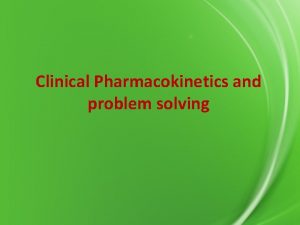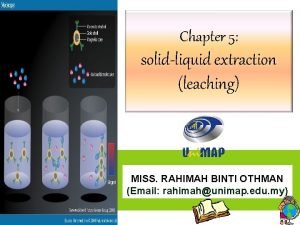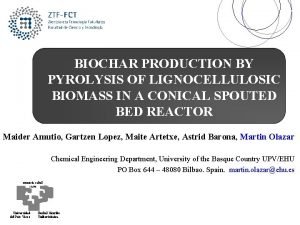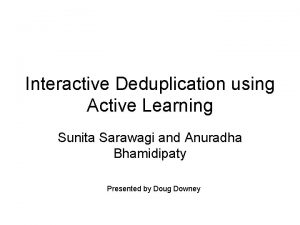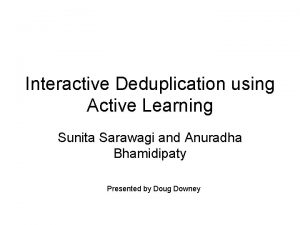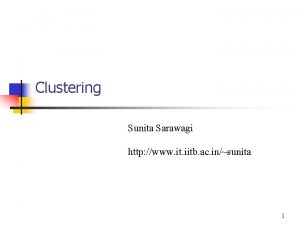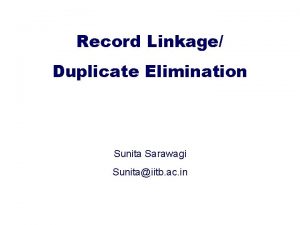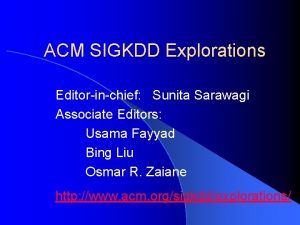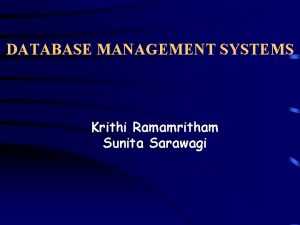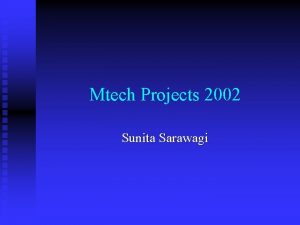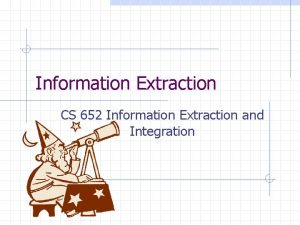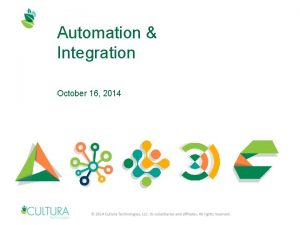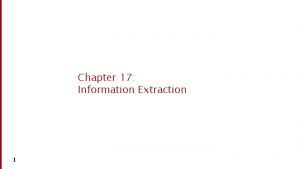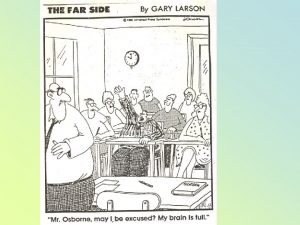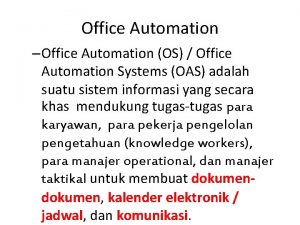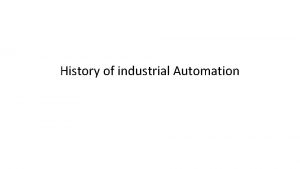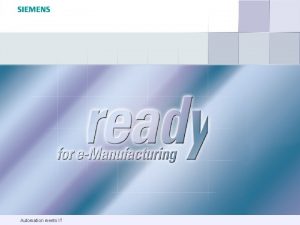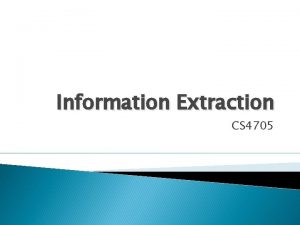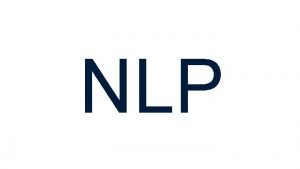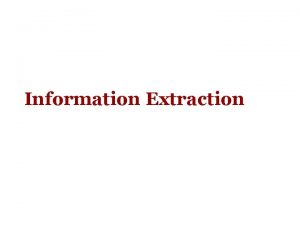Automation in Information Extraction and Integration Sunita Sarawagi

























































- Slides: 57

Automation in Information Extraction and Integration Sunita Sarawagi I I T Bombay sunita@it. iitb. ac. in Sarawagi 1

Data integration n n The process of integrating data from multiple, heterogeneous, loosely structured information sources into a single well-defined structured database A tedious exercise involving n n n schema mapping, structure/information extraction, duplicate elimination, missing value substitution, error detection standardization Sarawagi 2

Application scenarios n Large enterprises: n n n Phenomenal amount of time and resources spent on data cleaning Example: Segmenting and merging name-address lists during data warehousing Web: n Creating structured databases from distributed unstructured web-pages n n Citation databases: Citeseer and Cora Other scientific applications n Bio-informatics n Extracting relations from medical text (KDD cup 2002) Sarawagi 3

Case study: Cite. Seer n Paper location: n n n Extract publication records from specific publisher websites Extract ps/pdf files by searching the web with terms like “publications” Information extracted from papers: n n Title, author from header Extract citation entries è Bibliography section è Separate into individual records è Segment into title, author, date, page numbers etc n Duplicate elimination across several citations to a paper (de-duplication) Sarawagi 4

Recent trends n n Classical problem that has bothered researchers and practitioners for decades Several existing commercial solutions n n n Manual, domain-specific, data-driven scripting Example: Name/address cleaning Require high-expertise to code and maintain Emerging research interest in automating script building by learning from examples Several research prototypes, particularly in the context of web data integration Sarawagi 5

Scope of the tutorial n n Novel application of data mining and machine learning techniques to automate data cleaning operations. Integrate recent research from various areas: n n Machine learning, data mining, information retrieval, natural language processing, web wrapper extraction Focus on two operations n n Information Extraction Duplicate elimination Sarawagi 6

Outline n Information Extraction n n Duplicate elimination Reducing the need for training data: n n Rule-based methods Probabilistic methods Active learning Bootstrapping from structured databases Semi-supervised learning Summary and research problems Sarawagi 7

Information Extraction (IE) The IE task: Given, E: a set of structured elements or attribute names, S: unstructured source S n n extract all instances of E from S n Various levels of difficulty depending on input n n Extraction by segmenting text Extraction from formatted text – HTML wrappers Extraction from free-format text – classical IE Classical problem: spanning many areas n Natural language, HTML wrapping, digital library Sarawagi 8

IE by segmenting text Source: concatenation of structured elements with limited reordering and some missing fields n Example: Addresses, bib records House number Building Road Zip City 4089 Whispering Pines Nobel Drive San Diego CA 92122 Author Year Title Journal Volume Page P. P. Wangikar, T. P. Graycar, D. A. Estell, D. S. Clark, J. S. Dordick (1993) Protein and Solvent Engineering of Subtilising BPN' in Nearly Anhydrous Organic Media J. Amer. Chem. Soc. 115, 12231 -12237. Sarawagi 9

IE on formatted text: HTML wrappers Source <U><LI>P. P. Wangikar</U>, T. P. Graycar, D. A. Estell, D. S. Clark, J. S. Dordick (1993) <B>Protein and Solvent Engineering of Subtilisin BPN' in Nearly Anhydrous Organic Media</B> <I>J. Amer. Chem. Soc. </I> <B>115</B>, 1223112237. </LI> Output AUTHOR: YEAR: TITLE: JOURNAL: VOLUME: PAGE: Sarawagi P. P. Wangikar. . Dordick 1993 Protein …. Media J. Amer. Chem. Soc 115 12231 -12237 10

HTML Wrappers n Record level: n n Extracting elements of a single list of homogeneous records from a page Page-level: n Extracting elements of multiple kinds of records n n Example: name, courses, publications from home pages Site-level: n Example: populating a university database from pages of a university website Sarawagi 11

IE from free-format text n Examples: n n Gene interactions from medical articles Part number, problem description from emails in help centers Structured records describing an accident from insurance claims, Merging companies, their roles and amount from news articles Our scope: Shallow IE based on syntactic cues as against IE based on semantic cues and deep linguistics Ref: Message Understanding Conferences (MUC) Sarawagi 12

IE via machine learning Given several examples showing position of structured elements in text, Train a model to identify them in unseen text Issues: n n n What are the input features? What is the learning model? Are elements to be extracted independently? How much training data is required? How can one reduce the need for labeled data? Can one tell when the extractor is likely wrong? Sarawagi 13

Input features § Content words § Properties of words § capitalization, parts of speech § Prefix /suffix, formatting information § Inter-element sequencing § Intra-element sequencing § Element length § External database of semantic relationship § Richer structure: tree, tables Sarawagi 14

Structure of IE models Rule-based Independent/ Per-element Probabilistic Wein: Kushmerick 1997 Rapier: Calif 1999 Nymble: Bikel 1997 Freitag 1999 Stalker: Muslea 2001 Simultaneous Softmealy: Hsu 1998 Whisk: Soderland 1999 Sarawagi Seymore 1999 Datamold: Borkar 2001 15

Rule-based IE models Stalker (Muslea et al 2001) n Model type: Rules with conjuncts and disjuncts n n Features: n n html tags primarily punctuations predefined text features: is. Number, is. Capitalized Relationship between elements: n n For each element, two rules: start rules R 1 and end rule R 2 Independent within same level of hierarchy Training method: basic sequential rule covering algorithm Sarawagi 16

Example <LI> <U> P. P. Wangikar </U>, J. S. Dordick (1993) <B> Protein and Solvent Engineering of Subtilisin BPN' in Nearly Anhydrous Organic Media</B> <I>J. Amer. Chem. Soc. </I> <B>115</B>, 12231 -12237. </LI> <LI>A. Bhunia , S. Durani, <U>P. P. Wangikar</U> (2001) "Horseradish Peroxidase Mediated Degradation of Dyes" <I>Biotechnology and Bioengineering, </I> <B>72</B>, 562 -567. </LI> n Author: n n n Title: n n n R 1: skip. To( <li> ) R 2: skip. To( ( ) R 1: skip. To( <B> ) OR skip. To( “ ) disjunction R 2: skip. To( </B> ) OR skip. To( “ ) Volume: n n R 1: skip. To( <B> ) skipuntil(Number) conjunction R 2: skip. To( </B> ) Sarawagi 17

Limitations of rule-based approach n As in WEIN, Stalker n n n No ordering dependency between elements Non-overlap of elements not exploited Position information ignored Content largely ignored Heuristics to order rule firing and ordering Sarawagi 18

Finite state machines n Model ordering relationship between elements ( Softmealy, Hsu 1998) n n Node: elements to be extracted Transition edge: rules marking start of element. n Rules are similar to those in STALKER. Start <li> <B> Author <em> Journal <B> </B><em> Vol Title When more than one rule fires apply more specific rule All allowable permutations must appear in training data Sarawagi 19

IE with Hidden Markov Models n Probabilistic models for IE Emission probabilities Transition probabilities 0. 5 Author Y 0. 1 A 0. 1 C 0. 8 Year dddd 0. 8 dd 0. 2 0. 9 Title 0. 5 A 0. 6 B 0. 3 C 0. 1 0. 8 Journal 0. 2 Sarawagi X 0. 4 B 0. 2 Z 0. 4 20

HMM Structure n Naïve Model: One state per element Nested model Each element another HMM n Sarawagi 21

HMM Dictionary n For each word (=feature), associate the probability of emitting that word n n Multinomial model More advanced models with overlapping features of a word, n example, n n part of speech, capitalized or not type: number, letter, word etc Maximum entropy models (Mc. Callum 2000) Sarawagi 22

Learning model parameters n When training data defines unique path through HMM n Transition probabilities n Probability of transitioning from state i to state j = number of transitions from i to j total transitions from state i n Emission probabilities n Probability of emitting symbol k from state i = number of times k generated from i number of transition from I n When training data defines multiple path: n A more general EM like algorithm (Baum-Welch) Sarawagi 23

Using the HMM to segment n n Find highest probability path through the HMM. Viterbi: quadratic dynamic programming algorithm 115 Grant street Mumbai 400070 115 Grant ………. . 400070 House Road City Pint o o Pint Sarawagi 24

Comparative Evaluation n n Naïve model – One state per element in the HMM Independent HMM – One HMM per element; Rule Learning Method – Rapier Nested Model – Each state in the Naïve model replaced by a HMM Sarawagi 25

Results: Comparative Evaluation Dataset insta nces Elem ents IITB student 2388 Addresses 17 Company Addresses 769 6 US Addresses 740 6 The Nested model does best in all three cases (from. Sarawagi Borkar 2001) 26

HMM approach: summary Inter-element sequencing ð Outer HMM transitions Intra-element sequencing ð Inner HMM Element length ð Multi-state Inner HMM Characteristic words ð Dictionary Non-overlapping tags ð Global optimization Sarawagi 27

Information Extraction: summary Feature engineering is key: have to model how to combine them without undue complexity Rule-based Probabilistic n n And/or combination with heuristics to control firing Brittle to variations in data Require lesser training data, wrappers reported to learn with < 10 examples Used in HTML wrappers ð Joint probability distribution, more elegant ð Might get hard in general ð Can handle variations ð Used for text segmentation and NE extraction Sarawagi 28

Outline n Information Extraction n n Duplicate elimination Reducing the need for training data: n n Rule-based methods Probabilistic methods Active learning Bootstrapping from structured databases Semi-supervised learning Summary and research problems Sarawagi 31

The de-duplication problem Given a list of semi-structured records, find all records that refer to a same entity n Example applications: § Data warehousing: merging name/address lists n n Entity: a) Person b) Household Automatic citation databases (Citeseer): references n Entity: paper De-duplication: n is not unsupervised clustering n precise external notion of correctness Sarawagi 32

Challenges n n Errors and inconsistencies in data Spotting duplicates might be hard as they may be spread far apart: n n may not be group-able using obvious keys Domain-specific n Existing manual approaches require re-tuning with every new domain Sarawagi 33

Example: citations from Citeseer n Our prior: n n Author match could be hard: n n n duplicate when author, title, booktitle and year match. . L. Breiman, L. Friedman, and P. Stone, (1984). Leo Breiman, Jerome H. Friedman, Richard A. Olshen, and Charles J. Stone. Conference match could be harder: n n In VLDB-94 In Proc. of the 20 th Int'l Conference on Very Large Databases, Santiago, Chile, September 1994. Sarawagi 34

n n Fields may not be segmented, Word overlap could be misleading Non-duplicates with lots of word overlap § H. Balakrishnan, S. Seshan, and R. H. Katz. , Improving Reliable Transport and Hando Performance in Cellular Wireless Networks, ACM Wireless Networks, 1(4), December 1995. § H. Balakrishnan, S. Seshan, E. Amir, R. H. Katz, "Improving TCP/IP Performance over Wireless Networks, " Proc. 1 st ACM Conf. on Mobile Computing and Networking, November 1995. Duplicates with little overlap even in title § Johnson Laird, Philip N. (1983). Mental models. Cambridge, Mass. : Harvard University Press. § P. N. Johnson-Laird. Mental Models: Towards a Cognitive Science of Language, Inference, and Consciousness. Cambridge University Press, 1983 Sarawagi 35

Learning the de-duplication function Given examples of duplicates and non-duplicate pairs, learn to predict if pair is duplicate or not. Input features: n Various kinds of similarity functions between attributes n n n Edit distance, Soundex, N-grams on text attributes Absolute difference on numeric attributes Some attribute similarity functions are incompletely specified n n Example: weighted distances with parameterized weights Need to learn the weights first. Sarawagi 36

The learning approach Example labeled pairs Similarity functions f 1 f 2 …fn Record 1 D Record 2 1. 0 0. 4 … 0. 2 1 Record 1 N Record 3 0. 0 0. 1 … 0. 3 0 Record 4 D Record 5 Unlabeled list Record Record 6 7 8 9 10 11 Similarity functions Year. Difference > 1 Non-Duplicate All-Ngrams 0. 48 Non Duplicate Author. Title. Ngrams 0. 4 Duplicate Classifier Title. Is. Null < 1 Page. Match 0. 5 0. 3 0. 4 … 0. 4 1 Duplicat e Author. Edit. Dist 0. 8 Duplicate Mapped examples Non-Duplicate 0. 0 1. 0 0. 6 0. 7 0. 3 0. 0 0. 3 0. 6 0. 1 0. 4 0. 2 0. 1 0. 4 0. 1 0. 8 0. 1 … … … … 0. 3 0. 2 0. 5 0. 6 0. 4 0. 1 0. 5 ? ? ? ? Sarawagi 0. 0 0. 1 … 0. 3 Duplicate 1. 0 0. 6 0. 7 0. 3 0. 0 0. 3 0. 6 0. 4 0. 2 0. 1 0. 4 0. 1 0. 8 0. 1 … … … … 0. 2 0. 5 0. 6 0. 4 0. 1 0. 5 0 1 0 1 1 37

Learning attribute similarity functions n String edit distance with parameters: n n n C(x, y): cost of replacing x with y d: cost of deleting a character i: cost of inserting a character Learning parameters from examples showing matchings Transformed Examples: Akme Inc. n sequence of n n n Acme Incorporated Match Insert Deletes Mrmm mmmidddd [Bilenko & Mooney, 2002] [Ristad & Yianilos 1998 n Train a stochastic model on sequence Sarawagi 38

Summary: De-deduplication n Previous work concentrated on designing good static, domain-specific string similarity functions Recent spate of work on dynamic learning-based approach appears promising Two levels: n n Attribute-level: Tuning parameters of existing string similarity functions to match examples Record-level: Classifiers like SVMs and decision trees used to combine the similarity along various attributes saving the effort of tuning thresholds and conditions Sarawagi 39

Outline n Information Extraction n n Duplicate elimination Reducing the need for training data: n n Rule-based methods Probabilistic methods Active learning Bootstrapping from structured databases Semi-supervised learning Summary and research problems Sarawagi 40

Active learning n Ordinary learner: n n learns from a fixed set of labeled training data Active learner: n n n Selects unlabeled examples from a large pool and interactively seeks their labels from a user Careful selection of examples could lead to faster convergence Useful when unlabeled examples are abundant and labeling them requires human effort Sarawagi 42

Example: active learning Assume: Points from two classes (red and green) on a real line perfectly separable by a single point separator labeled points Unlabeled points y Sure reds Region of uncertainity Sure greens Need greatest expected reduction in the size of the uncertainty region That often corresponds to point with highest prediction uncertainty Sarawagi 43

Measuring prediction certainty n Classifier-specific methods n Support vector machines: n n Naïve Bayes classifier: n n Posterior probability of winning class Decision tree classifier: n n Distance from separator Weighted sum of distance from different boundaries, error of the leaf, depth of the leaf, etc Committee-based approach: (Seung, Opper, and Sompolinsky 1992) n n Disagreements amongst members of a committee Most successfully used method Sarawagi 46

Forming a classifier committee Randomly perturb learnt parameters n Probabilistic classifiers: . n n n Sample from posterior distribution on parameters given training data. Example: binomial parameter p has a beta distribution with mean p Discriminative classifiers: n Random boundary in uncertainty region Sarawagi 47

Committee-based algorithm n n Train k classifiers C 1, C 2, . . Ck on training data For each unlabeled instance x n n Find prediction y 1, . . , yk from the k classifiers Compute uncertainty U(x) as entropy of above y-s Pick instance with highest uncertainty Sampling for representativeness: With weight as U(x), do weighted sampling to select an instance for labeling. n Sarawagi 48

Active learning in deduplication with decision trees Forming committee of trees by random perturbation n Selecting split attribute n n n Normally: attribute with lowest entropy Perturbed: random attribute within close range of lowest Selecting a split point n n Normally: midpoint of range with lowest entropy Perturbed: a random point anywhere in the range with lowest entropy Sarawagi 49

Speed of convergence Learning deduplication function on Bibtex entries n With 100 pairs: n n Active learning: 97% (peak) Random: only 30% (from Sarawagi 2002) Sarawagi 50

Active learning in IE with HMM Forming committee of HMMs by random perturbation n Emission and transition probabilities are independent multinomial distributions. n Posterior distribution for Multinomial parameters: n n Dirichlet with mean estimated as using maximum likelihood Results on part of speech tagging (Dagan 1999) n 92. 6% accuracy using active learning with 20, 000 instances as against 100, 000 random Sarawagi 51

Active learning in rule-based IE Stalker (Muslea et al 2000) n Learn two classifiers: n n one based on a forward traversal of the document, second based on a backward traversal Select for labeling those records that get conflicting prediction from the two Performance: 85% accuracy without active learning yield 94% with active learning Sarawagi 52

Bootstrapping from structured databases n Given a database of structured elements n n n Segment to best match with the database HMM: n n n Example: collection of structured bibtex entries Initialize dictionary using database Learn transitions using Baum Welch on unlabeled data Assigning probabilities hard Still open to investigation Rule-based IE: (Snowball, Agichtein 2000) Sarawagi 53

Semi-supervised learning n n Can unlabeled data improve classifier accuracy? Possibly, for probabilistic classifiers like HMMs n n Use labeled data to train an initial model Use Baum Welch on unlabeled data to refine model to maximize data likelihood Unfortunately, no gain in accuracy reported (Seymore 1999) Needs further investigation Sarawagi 55

Summary n Information Extraction n Various levels of complexity depending on input n n Model-type: n n Segmentation, HTML wrappers, free-format Rule-based and probabilistic (HMM) Independent or simultaneous Several research prototypes in each type Duplicate elimination n n Challenging because of variations in data format Learning applied to design deduplication function Sarawagi 56

Summary n Active learning n n n Various methods proposed Committee-based sampling most popular Application with n n HMM for IE Decision trees for deduplication Sarawagi 57

Topics of further research n Information Extraction: n n n Exploiting higher-level structures in input data, e. g. trees, tables Integrated learning in the presence of a large structured DB, small labeled data and large unlabeled data Wrappers at the website level involving several structured tables Efficiency in the presence of a large database/dictionary Duplicate elimination n n Multi-table de-duplication Integrating semi-supervised and active learning Efficient active learning without requiring materialization of all possible pairs Efficient evaluation of a de-duplication function Sarawagi 58

Topics of further research n n n Combining machine learning of extraction patterns with human generated scripts Updating models as data arrives: continuous learning Going from research prototypes to robust products and toolkits Sarawagi 59

References n General n n n H. Galhardas, D. Florescu, D. Shasha, E. Simon, and C. Saita. Declarative data cleaning: Language, model and algorithms. VLDB, 2001. S. Lawrence, C. L. Giles, and K. Bollacker. Digital libraries and autonomous citation indexing. IEEE Computer, 32(6): 67 -71, 1999. A. Mc. Callum, K. Nigam, J. Reed, J. Rennie, and K. Seymore. Cora: Computer science research paper search engine. http: //cora. whizbang. com/, 2000. IEEE Data Engineering special issue on Data Cleaning. http: //www. research. microsoft. com/research/db/debull/A 00 dec/issue. htm, December 2000. M. A. Hernandez and S. J. Stolfo. Real-world data is dirty: Data cleansing and the merge/purge problem. Data Mining and Knowledge Discovery, 2(1), 1998. Information extraction n n n E. Agichtein, L. Gravano, “Snowball: Extracting relations from large plaintext collections", ACM Intl. Conf. on Digital Libraries“ 2000 D M. Bikel, S Miller, R Schwartz and R. Weischedel, "Nymble: a high-performance learning name-finder", ANLP 1997, Vinayak R. Borkar, Kaustubh Deshmukh, and Sunita Sarawagi. Automatic text segmentation for extracting structured records. SIGMOD 2001. Mary Elaine Calif and R. J. Mooney. Relational learning of pattern-match rules for information extraction. AAAI 1999. D Freitag and A Mc. Callum, Information Extraction with HMM Structures Learned by Stochastic Optimization, AAAI 2000 A. Mc. Callum and D. Freitag and F. Pereira, Maximum entropy Markov models for information extraction and segmentation, ICML-2000 Sarawagi 60

References n n n K Seymore, A Mc. Callum, R Rosenfeld. Learning Hidden Markov Model structure for information extraction. AAAI Workshop on Machine Learning for Information Extraction, 1999. S. Soderland. Learning information extraction rules for semi-structured and free text. Machine Learning, 34, 1999. Wrappers n n n n n C. Y. Chung, M. Gertz, and N. Sundaresan. Reverse engineering for web data: From visual to semantic structures. ICDE 2002. William W. Cohen, Matthew Hurst, and Lee S. Jensen. A exible learning system for wrapping tables and lists in html documents. WWW 2002. David W. Embley, Y. S. Jiang, and Yiu-Kai Ng. Record-boundary discovery in web documents. In SIGMOD 1999. C. -N. Hsu and M. -T. Dung. Generating finite-state transducers for semistructured data extraction from the web. Information Systems Special Issue on Semistructured Data, 23(8), 1998. N. Kushmerick, D. S. Weld, and R. Doorenbos. Wrapper induction for information extraction. IJCAI, 1997. L. Liu, C. Pu, and W. Han. Xwrap: An XML-enabled wrapper construction system for web information sources. ICDE, 2000. Ion Muslea, Steven Minton and Craig A. Knoblock, Hierarchical Wrapper Induction for Semistructured Information Sources, "Autonomous Agents and Multi-Agent Systems", 2001. Jussi Myllymaki. Effective web data extraction with standard XML technologies. WWW, 2001. Sarawagi 61

References n Duplicate elimination n n A Z. Broder, S C. Glassman, M S. Manasse, Geoffrey Zweig, “Syntactic Clustering of the Web”, WWW 1997 M. G. Elfeky, V. S. Verykios, A. K. Elmagarmid, “Tailor: A record linkage toolkit”, ICDE 2002. S Sarawagi and Anuradha Bhamidipaty, Interactive deduplication using active learning, ACM SIGKDD 2002 W. E. Winkler. Matching and record linkage. In B. G. C. et al, editor, Business Survey Methods, pages 355 -384. New York: J. Wiley, 1995. Active and semi-supervised learning n n n Shlomo Argamon-Engelson and Ido Dagan. Committee-based sample selection for probabilistic classififers. J. of Artificial Intelligence Research, 11: 335 --360, 1999. Yoav Freund, H. Sebastian Seung, Eli Shamir, and Naftali Tishby. Selective sampling using the query by committee algorithm. Machine Learning, 28(2 -3): 133 -168, 1997. Ion Muslea, Steve Minton, and Craig Knoblock. “Selective sampling with redundant views". AAAI, 2000 H. S. Seung, M. Opper, and H. Sompolinsky. Query by committee. In Computational Learing Theory, pages 287 -294, 1992. T. Zhang and F. J. Oles. A probability analysis on the value of unlabeled data for classification problems. ICML, 2000 Sarawagi 62

Manual Vs learning approach Learning Manual n Label examples n Inspect patterns n Choose & train model n Code scripts n Requires high-skill n Low-skill, cheaper labor for most part programmer n Feature design and model selection requires very high skill Sarawagi 63
 Sunita sarawagi
Sunita sarawagi Sarawagi san diego
Sarawagi san diego Sarawagi san diego
Sarawagi san diego Sunita mahajan
Sunita mahajan Sarawagi md
Sarawagi md Sunita mahajan
Sunita mahajan Sarawagi monica md
Sarawagi monica md Pedra negra meca
Pedra negra meca Sunita dodani
Sunita dodani Three dimensions of corporate strategy
Three dimensions of corporate strategy Forward and backward integration
Forward and backward integration Example of simultaneous integration
Example of simultaneous integration Temporal information extraction
Temporal information extraction Key information extraction
Key information extraction Information extraction algorithms
Information extraction algorithms Information oriented application integration
Information oriented application integration Information-oriented approach
Information-oriented approach Types of application integration
Types of application integration Practical extraction and reporting language
Practical extraction and reporting language Define maceration in pharmaceutics
Define maceration in pharmaceutics Miller and potts elevator
Miller and potts elevator Contraindication of extraction
Contraindication of extraction Indications of extraction
Indications of extraction Data extraction cleanup and transformation tools
Data extraction cleanup and transformation tools Difference between dna and rna extraction
Difference between dna and rna extraction Chelex dna extraction advantages and disadvantages
Chelex dna extraction advantages and disadvantages Practical extraction and report language
Practical extraction and report language Practical extraction and reporting language
Practical extraction and reporting language Siemens energy automation
Siemens energy automation Extract transform and load automation
Extract transform and load automation Parts of ventouse
Parts of ventouse Definition of exodontia
Definition of exodontia Hepatic clearance
Hepatic clearance Thar sfe
Thar sfe Strawberry dna extraction materials
Strawberry dna extraction materials Method of metal extraction
Method of metal extraction Nance serial extraction
Nance serial extraction Partial breech extraction
Partial breech extraction Water extraction montarra
Water extraction montarra Microwave assisted extraction
Microwave assisted extraction Hepatic extraction ratio formula
Hepatic extraction ratio formula Liver circulation
Liver circulation Extraction of metals
Extraction of metals La chlorophylle brute
La chlorophylle brute Glycomet
Glycomet Hepatic extraction ratio
Hepatic extraction ratio Extraction factor
Extraction factor Penicillin extraction
Penicillin extraction Straight elevator principle
Straight elevator principle Easyblue
Easyblue Kiwi dna extraction lab
Kiwi dna extraction lab O2 extraction ratio
O2 extraction ratio Cobol data extraction
Cobol data extraction Hepatic extraction ratio formula
Hepatic extraction ratio formula Sieve tray tower
Sieve tray tower Moving bed leaching equipment
Moving bed leaching equipment Canadian oil and gas trusts
Canadian oil and gas trusts Spouted bed extraction
Spouted bed extraction
